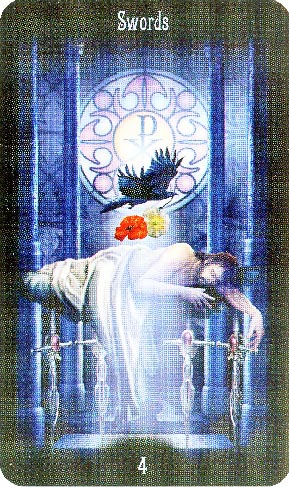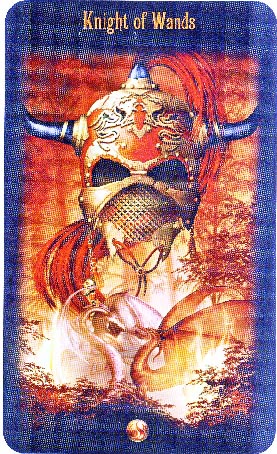
This is awarded artist Ciro Marchetti’s third tarot deck, following the popular Gilded Tarot and the Tarot of Dreams. There is some debate about the merit of employing digital rather than hand-rendered art in the creation of tarot decks, but obviously Marchetti’s tarots have found a welcoming audience.
Marchetti embraces a fresh approach when creating this tarot deck, and he provides an unusual science-fiction back story as the inspiration for the deck’s imagery. This story is found in the opening chapters of “Gateway to the Divine Tarot,” the accompanying text. Whether readers find this background tale interesting and relevant is a matter of personal taste. What readers will definitely find useful is the four-fold card meaning descriptions provided by a diverse, top-notch writing team: Ruth Ann and Wald Amberstone, James Ricklef, and Leisa ReFalo. This multi-writer approach to card definitions makes the accompanying book something far out of the ordinary.
The cards demonstrate of Marchetti’s mastery of the digital art medium. Some cards are almost photographic in quality, like the Queens and Pages, while other cards are rendered with dream-like fantasy imagery. For instance, in the Four of Swords, a sleeping man floats over, or is supported by, four swords. A raven, a symbol of the soul, flies past a rose window bearing a red and a white poppy, symbolizing death and sleep. The Chi-Ro symbol is at the center of the rose window, which the author relates is the source of his first name. The fantasy theme is prominently evident in the Three of Wands, which depicts a person waiting on a shore watching an air ship approach. The air ship is reminiscent of Captain Shakespeare’s floating ship in “Stardust,” or of the air-ship to the moon depicted in “The Adventures of Baron Munchausen.” Indeed, thumbing through the cards for the first time was like seeing still-frame capsules from a variety of sci-fi and fantasy films.
The deck exudes an otherworldly quality which is as the artist intends. Background fields are often misty or clouded skies with cursory geographic reference. Interior settings are tight shots that feature stone walls or raised dais surrounded by pillars. While these convey a wisp of epic quality, they are restricted glimpses of an imaginary realm. Marchetti chose to include Golden Dawn zodiacal attributions to some, but not all, of the cards.
In an unusual artistic decision, the knights are portrayed as battle helms suspended over action-filled settings. In the Knight of Wands, a red and gold horned helmet hovers over fighting dragons; in the Knight of Pentacles, a similarly fabulous helmet is depicted with sparring stallions.
The artist strikes gold when he creates continuity between sequential cards. For instance, in the Tower, a spherical structure mounted on four elemental pillars collapses as two of the pillars are struck by meteors from outer space (my first impression was of phazer strikes from a Romulan warbird). In the following card, The Star, an ethereal naked lady floats over the wreckage of the building and sprinkles star dust on it. Sequential imagery serves to better integrate the story-telling capacity of a tarot deck, and makes the deck more effective and convincing as a whole.
What is less effective is the inconsistent costuming. The overall impression is of a movie-lot rummage sale. The Emperor wears a “Star Gate” costume, while the King of Coins obviously got Prince Humperdink’s outfit from the “Princess Bride.” The Pages are wearing page outfits from Elizabethan costume dramas, while the lady in the Strength card got Grace Jones’ outfit from “Conan the Barbarian.” While the art is undeniably beautiful, the costuming doesn’t attain the level of the other elements of tarot imagery. Given the science-fiction lead story on the origin of this tarot deck, a more cohesive and genuinely original take on the garb of the natives of this alien world should have been a priority.
That said, Marchetti achieves incredible creative leaps in his more strictly symbolic renderings. In the Two of Wands, a key hovers between two locked boxes. This is a unique and visually intriguing way to convey this card’s divinatory meaning. In the Sun card, a gigantic sun is surrounded by much smaller planets suspended on strings – a visually satisfying and original rendering. The artist seems to have danced outside of the RWS box here and there, but then retreated back to it for moments of safety as is shown in the Nine of Pentacles: woman with bird in garden. Ho hum, yawn.
For sheer beauty, color, and internal consistency, this deck rates full marks. For original concept, again, full marks. For following through on a perfect jumping-off point for working outside of the RWS models, disappointing marks given Marchetti’s reputation and undeniable artistic mastery of his medium.
~review by Elizabeth Hazel
Tarot deck and book by Ciro Marchetti (with Ruth Ann and Wald Amberstone, James Ricklef, and Leisa ReFalo).
Llewellyn Worldwide, 2009, boxed 78-card deck and book (310 pp), $29.95.
(previously published in the ATA Quarterly Journal, Fall 2009 issue)




